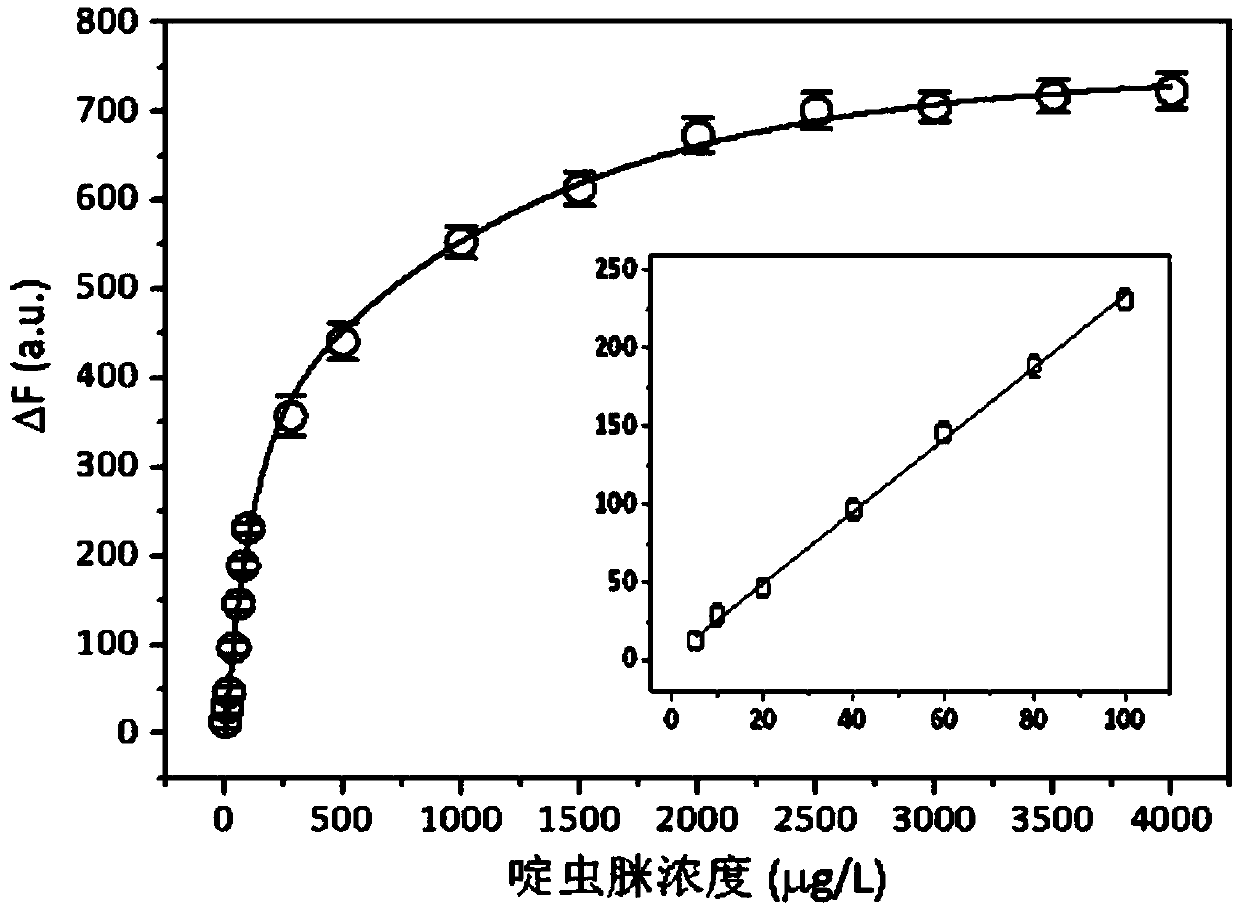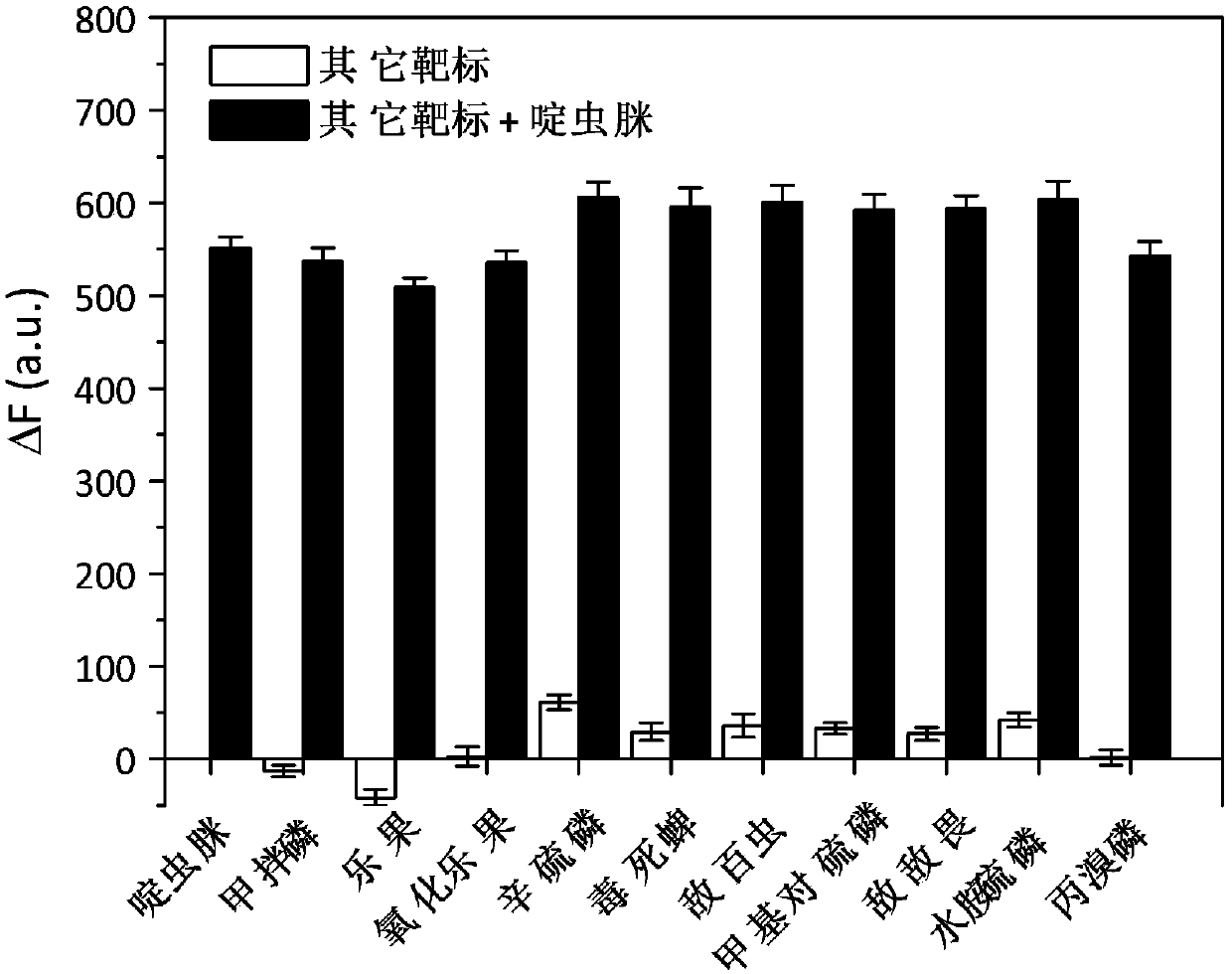Acetamiprid pesticide detection method based on carbon dot fluorescence inner-filter effect
A technology of carbon dot fluorescence and detection method, applied in fluorescence/phosphorescence, measuring device, material analysis by optical means, etc., can solve the problems of lower sensitivity than instrument method, environmental human hazard, low accuracy, etc., and achieve simple and fast operation. , high sensitivity, easy to build effects
- Summary
- Abstract
- Description
- Claims
- Application Information
AI Technical Summary
Problems solved by technology
Method used
Image
Examples
Embodiment 1
[0042]Embodiment 1 of the present invention: a method for detecting acetamiprid pesticide based on carbon dot fluorescent inner filter effect, comprising the following steps:
[0043] A: Draw a standard curve of the relationship between the concentration of acetamiprid and the change in fluorescence intensity, the standard curve is attached figure 2 shown, which includes the following steps:
[0044] A1: prepare the test sample liquid of known acetamiprid concentration, get A1 product. The specific method is: take 16 1.5mL graduated centrifuge tubes, add 10.0 μL of a standard solution of acetamiprid with a known concentration and 5.0 μL of acetamiprid aptamer with a concentration of 25 nM in each graduated centrifuge tube, and mix well After incubation at 25°C for 15 min, then add 100.0 μL of AuNPs (nano-gold) solution with a concentration of 3.2 nM, mix well, and incubate at 25°C for 15 min, then add 20.0 μL of AuNPs with a concentration of 0.2 mg· ml -1 The CDs (carbon d...
Embodiment 2
[0055] Embodiment 2 of the present invention: a method for detecting acetamiprid pesticide based on carbon dot fluorescent inner filter effect, comprising the following steps:
[0056] A: Draw a standard curve of the relationship between the concentration of acetamiprid and the change in fluorescence intensity, which includes the following steps:
[0057] A1: prepare the test sample liquid of known acetamiprid concentration, get A1 product. The specific method is: take 16 1.5mL graduated centrifuge tubes, add 10.0 μL of a standard solution of acetamiprid with a known concentration and 5.0 μL of acetamiprid aptamer with a concentration of 25 nM in each graduated centrifuge tube, and mix well After incubation at 30°C for 10min, then add 100.0μL of AuNPs solution with a concentration of 3.2nM, mix well, and incubate at 30°C for 10min, then add 20.0μL of AuNPs solution with a concentration of 0.2mg·ml -1 The CDs solution was mixed thoroughly and then incubated at 30°C for 10 min....
Embodiment 3
[0068] Embodiment 3 of the present invention: a method for detecting acetamiprid pesticide based on carbon dot fluorescent inner filter effect, comprising the following steps:
[0069] A: Draw a standard curve of the relationship between the concentration of acetamiprid and the change in fluorescence intensity, which includes the following steps:
[0070] A1: prepare the test sample liquid of known acetamiprid concentration, get A1 product. The specific method is: take 16 1.5mL graduated centrifuge tubes, add 10.0 μL of a standard solution of acetamiprid with a known concentration and 5.0 μL of acetamiprid aptamer with a concentration of 25 nM in each graduated centrifuge tube, and mix well After incubation at 35°C for 5min, then add 100.0μL of AuNPs solution with a concentration of 3.2nM and mix well, then incubate at 35°C for 5min, then add 20.0μL of AuNPs solution with a concentration of 0.2mg·ml -1 The CDs solution was mixed thoroughly and then incubated at 35°C for 5 min...
PUM
 Login to View More
Login to View More Abstract
Description
Claims
Application Information
 Login to View More
Login to View More - R&D
- Intellectual Property
- Life Sciences
- Materials
- Tech Scout
- Unparalleled Data Quality
- Higher Quality Content
- 60% Fewer Hallucinations
Browse by: Latest US Patents, China's latest patents, Technical Efficacy Thesaurus, Application Domain, Technology Topic, Popular Technical Reports.
© 2025 PatSnap. All rights reserved.Legal|Privacy policy|Modern Slavery Act Transparency Statement|Sitemap|About US| Contact US: help@patsnap.com



